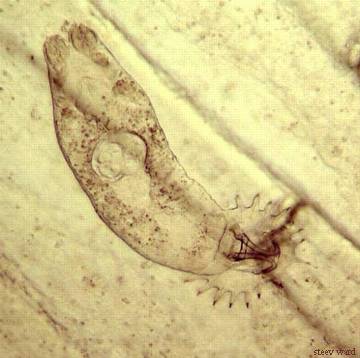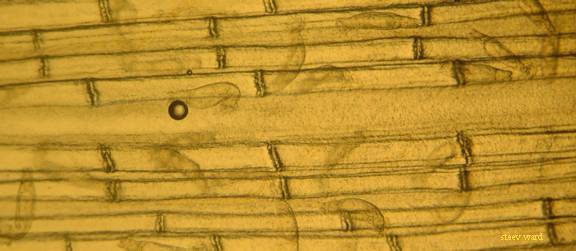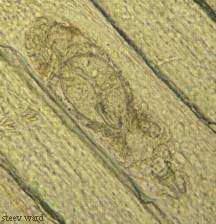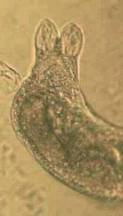 Class: Monogenea
Class: Monogenea| . |
 Gyrodactylus et al.
Gyrodactylus et al. Phylum: Platyhelminthes
 Class: Monogenea
Class: Monogenea
 Before the Monogeneans were split into their own class they were listed in the class Trematoda and are often still referred to as monogenetic trematodes. The taxonomy of these organisms is rather complex and there are many species and genera both freshwater and marine so I will not delve into that here but use the more casual distinctions common in the ornamental fish industry. Under this custom we refer to monogenetic and digenetic flukes (the Digenea are still considered in the class Trematoda), and divide the monogeneans further into skin flukes and gill flukes. Gyrodactylus is the most well-known genus of what we call the skin flukes and so I will use that name for organisms on this page even though there are many other species and genera involved. Skin flukes are often called “Gyros,” a nickname which should be used sparingly.
Before the Monogeneans were split into their own class they were listed in the class Trematoda and are often still referred to as monogenetic trematodes. The taxonomy of these organisms is rather complex and there are many species and genera both freshwater and marine so I will not delve into that here but use the more casual distinctions common in the ornamental fish industry. Under this custom we refer to monogenetic and digenetic flukes (the Digenea are still considered in the class Trematoda), and divide the monogeneans further into skin flukes and gill flukes. Gyrodactylus is the most well-known genus of what we call the skin flukes and so I will use that name for organisms on this page even though there are many other species and genera involved. Skin flukes are often called “Gyros,” a nickname which should be used sparingly.  When conditions are suitable and fish populations are high skin flukes can multiply rapidly and the damage done to the host by the attachment organs of the flukes can result in high mortalities, therefore their presence in the aquarium is most often considered grounds for therapeutic treatment. Secondary infections may include bacterial septicemia in fluke-infected fish, resulting in diverse clinical signs. On the other hand small numbers of the organisms should not be claimed responsible for fish deaths without considering other causes.
When conditions are suitable and fish populations are high skin flukes can multiply rapidly and the damage done to the host by the attachment organs of the flukes can result in high mortalities, therefore their presence in the aquarium is most often considered grounds for therapeutic treatment. Secondary infections may include bacterial septicemia in fluke-infected fish, resulting in diverse clinical signs. On the other hand small numbers of the organisms should not be claimed responsible for fish deaths without considering other causes.

This heavy a load of skin flukes will cause clamped fins and often result in death of smaller fish.
Diagnosis:
 Outward signs of a Gyrodactylus infection are clamped fins and labored movment. Secondarily there may be fungal or bacterial infection and resultant sores. Common in goldfish, koi, and other pond-raised fish, they are found on many other fish as well, including wild imports. Diagnosis of the disease is by observation of the flukes in a skin scraping or fin sample from an infected fish. If smaller numbers are found the sample size should be expanded to help provide a better estimate of the concentration of parasites. Under certain conditions the spread of the organism can be very uneven with some fish being heavily parasitized and others unaffected.
Outward signs of a Gyrodactylus infection are clamped fins and labored movment. Secondarily there may be fungal or bacterial infection and resultant sores. Common in goldfish, koi, and other pond-raised fish, they are found on many other fish as well, including wild imports. Diagnosis of the disease is by observation of the flukes in a skin scraping or fin sample from an infected fish. If smaller numbers are found the sample size should be expanded to help provide a better estimate of the concentration of parasites. Under certain conditions the spread of the organism can be very uneven with some fish being heavily parasitized and others unaffected.

 The size of the parasites (about 0.2mm) allows them to be seen at relatively low magnification, but they are easily overlooked if pressed tightly onto the sample under a coverslip or when the sample is too thick. In such cases the shape can be distorted and they are most easily spotted by recognizing the large pair of hooks at the attachment end. This is also the feature to look for when examining frozen samples. Careful adjustment of the light and condensor of the microscope can make a big difference in visibility. Often a skin fluke will be carrying an embryo so that there is an extra set of hooks visible inside the parent as seen in this photograph.
The size of the parasites (about 0.2mm) allows them to be seen at relatively low magnification, but they are easily overlooked if pressed tightly onto the sample under a coverslip or when the sample is too thick. In such cases the shape can be distorted and they are most easily spotted by recognizing the large pair of hooks at the attachment end. This is also the feature to look for when examining frozen samples. Careful adjustment of the light and condensor of the microscope can make a big difference in visibility. Often a skin fluke will be carrying an embryo so that there is an extra set of hooks visible inside the parent as seen in this photograph.
Click on photograph for a view with different light and focal settings on the microscope.
 Quite often, but not always, skin flukes can be noticed by their movement (extending and contracting).
Quite often, but not always, skin flukes can be noticed by their movement (extending and contracting).
A typical Gyrodactylus type skin fluke has two lobed projections on the posterior end and a set of large hooks surrounded by about twenty smaller hooks at the anterior end (opisthaptor). While it may not be possible to accurately identify the species of fluke that one is working with it may be of some practical value in evaluating treatment effectiveness to note external characteristics of specimens and make some arbitrary distinctions among them. It is not uncommon to encounter flukes that are resistant to the medications used to treat them and cultured fish may be more likely than wild fish to carry resistant strains.
Treatment:
 Most frequently flukes are treated with organophosphates: Trichlorphon, Dylox, Fluke Tabs®, and Lifebearer®.
Most frequently flukes are treated with organophosphates: Trichlorphon, Dylox, Fluke Tabs®, and Lifebearer®.
Addition of salt to the water is sometimes used as treatment, but is only moderately effective. Salt dips (strong salt solution for a period of one minute or less) are often effective in removing the parasites.
 Formalin baths are effective if done accurately. Long-term formalin baths of two drops per gallon standard formalin may or may not be effective.
Formalin baths are effective if done accurately. Long-term formalin baths of two drops per gallon standard formalin may or may not be effective.
 I have had some success using acriflavin for treatments of skin flukes by two methods. One was by maintaining a concentration of acriflavin in the water for a period of one week. Another method was by using a full dose of acriflavin in an aquarium which had been drained to 10% of it's normal volume for twenty minutes before refilling. Due to the nature of the solutions used it is not possible to accurately convey the dosages. Such a treatment may be worthwhile when treating fish such as Metynnis which are sensitive to the organophosphates, or Mormyrids and Ghost Knifefish which are sensitive to formalin.
I have had some success using acriflavin for treatments of skin flukes by two methods. One was by maintaining a concentration of acriflavin in the water for a period of one week. Another method was by using a full dose of acriflavin in an aquarium which had been drained to 10% of it's normal volume for twenty minutes before refilling. Due to the nature of the solutions used it is not possible to accurately convey the dosages. Such a treatment may be worthwhile when treating fish such as Metynnis which are sensitive to the organophosphates, or Mormyrids and Ghost Knifefish which are sensitive to formalin.
 The most immediate and perhaps most effective treatment is the use of a potassium permanganate dip (KMnO4) which I will not describe here except to recommend this site: http://edis.ifas.ufl.edu/FA032 . The use of 2ppm potassium permanganate as an extended bath is sometimes recommended and its effectiveness depends partly on water quality and substrate conditions as well as filtration. Fish species differ in their sensitivity to potassium permanganate, goldfish and koi handling it quite well. Hydrogen peroxide is handy for neutralizing potassium permanganate if necessary.
The most immediate and perhaps most effective treatment is the use of a potassium permanganate dip (KMnO4) which I will not describe here except to recommend this site: http://edis.ifas.ufl.edu/FA032 . The use of 2ppm potassium permanganate as an extended bath is sometimes recommended and its effectiveness depends partly on water quality and substrate conditions as well as filtration. Fish species differ in their sensitivity to potassium permanganate, goldfish and koi handling it quite well. Hydrogen peroxide is handy for neutralizing potassium permanganate if necessary.
There are a number of new anthelminthic drugs which may be useful in treating these parasites.
| See page two. More photos of skin flukes. | Page three. An unusual species found on a plecostomus. | Pathogens List |